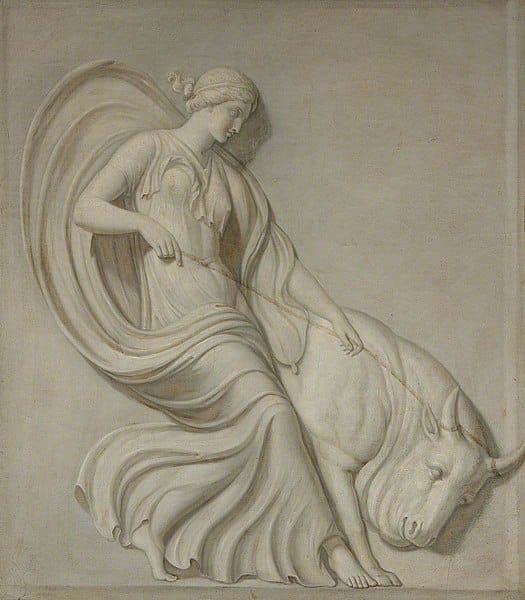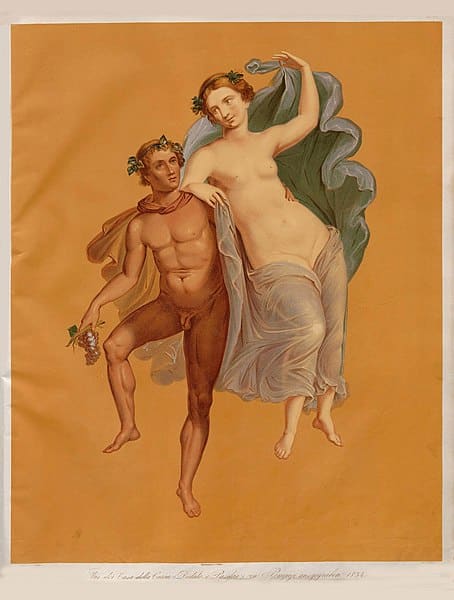The annals of Greek mythology are replete with tales of heroism, love, and divine intervention. Yet, nestled among these legends is the story of Pasiphae, the Cretan queen whose desires led to the birth of one of the most infamous creatures in history.
Pasiphae’s Key Facts
| Keyword | Fact |
| Parents | Helios and Perse |
| Partners | King Minos |
| Siblings | Circe, Aeetes, Perses |
| Offspring | Minotaur, Ariadne, Phaedra, and others |
| Other names | – |
| Roman name | Pasiphaë |
| Best Known Myth | Love for the Cretan Bull leading to Minotaur |
Name and Etymology
Pasiphae, a name that resonates with mystery, is derived from the Greek words “pas” and “phaos”, meaning “all” and “light” respectively. This etymology is fitting, given her lineage as the daughter of Helios, the Sun god. In Roman mythology, she is known as Pasiphaë, retaining much of the essence of her Greek counterpart.
Her name, embodying the concept of all-encompassing light, not only ties her to her divine parentage but also hints at the illuminating, albeit sometimes tragic, role she plays in the myths of ancient Greece. The Roman adaptation of her name, Pasiphaë, is a testament to the enduring nature of her tales, which transcended borders and found resonance in various cultures.

Pasiphae’s Family and Relationships
Born to the Sun god Helios and the Oceanid Perse, Pasiphae’s lineage was nothing short of illustrious. Her siblings included the enchantress Circe and the king Aeetes, both prominent figures in Greek myths. Such a divine heritage set the stage for a life intertwined with gods, heroes, and the inexorable pull of fate.
Her marriage to King Minos of Crete further solidified her status. Together, they had several children, including the famed Ariadne and Phaedra. However, it wasn’t just familial ties that defined Pasiphae. A curse placed upon her by Poseidon led to an unnatural love for a majestic Cretan bull; a passion that culminated in the birth of the Minotaur, a creature half-man, half-bull, that would later haunt the labyrinths of Crete.
While her role as a mother and queen was significant, her relationships were often marred by divine interventions and the whims of gods. Her interactions with figures like Briseis, Menelaus, and Agamemnon, pivotal players in the Trojan War, further entangled her in the intricate web of Greek mythology.
Myths about Pasiphae
Pasiphae’s life, as depicted in Greek mythology, is a tapestry of passion, divine intervention, and the complexities of human emotion. Her tales, while not as numerous as some other figures in mythology, are deeply impactful and have left an indelible mark on the annals of ancient stories.
The Birth of the Minotaur
Arguably the most renowned tale associated with Pasiphae is her unnatural love for the Cretan bull. This wasn’t a mere whim of passion; it was the result of a curse. King Minos, her husband, had promised to sacrifice a majestic bull to Poseidon. However, when he broke this vow, the sea god, in retaliation, made Pasiphae fall deeply and uncontrollably in love with the creature.
Desperate to be with the bull, Pasiphae sought the help of Daedalus, a master craftsman. He constructed a hollow wooden cow, allowing Pasiphae to hide inside and thus, consummate her love for the bull. This union led to the birth of the Minotaur, a creature with the body of a man and the head of a bull. The Minotaur became a symbol of shame for King Minos, who later imprisoned the creature in the Labyrinth, also constructed by Daedalus.
Pasiphae and the Love Potion
Pasiphae’s relationship with King Minos was tumultuous, to say the least. Distraught over Minos’s numerous infidelities, Pasiphae decided to take matters into her own hands. She sought the expertise of a sorcerer to concoct a potion that would ensure Minos’s fidelity. However, as is often the case with magic, things didn’t go as planned. Instead of drawing him closer, the potion repulsed Minos, driving a further wedge between the royal couple. This tale underscores the unpredictable nature of love and the lengths one might go to preserve it.
Depiction And Characteristics
Pasiphae, in her depictions, often embodies the regality of a queen and the ethereal beauty befitting a daughter of the Sun. Yet, there’s an underlying hint of sorrow, perhaps a nod to her tumultuous love life and the challenges she faced. Symbols associated with her often include the bull, representing her fateful attraction, and the labyrinth, a testament to the intricate challenges of her life.
Her personality, as gleaned from myths, is multifaceted. She often showcases the love and dedication of a mother and queen. However, there are moments of vulnerability, passion, and even raw desperation. Her tale, serves to convey the duality of human nature and the thin line between love and obsession.
Animals like the bull and symbols like the labyrinth are frequently associated with Pasiphae. These not only tie her to her most famous myth but also serve as reminders of the intricate dance between fate, free will, and divine intervention in her life.
Representations Of Pasiphae In Art
Pasiphae’s enigmatic tale has inspired countless artists over the millennia. From ancient pottery showcasing her with the Cretan bull to Renaissance paintings that capture her ethereal beauty, her influence in art is undeniable. One of the most notable depictions is the fresco in Pompeii. There she’s portrayed amidst the backdrop of the labyrinth, a poignant reminder of her complex life.
Her representation often oscillates between a regal queen and a woman ensnared by her desires. This duality offers a glimpse into her psyche, where she, despite her divine lineage, grappled with very human emotions.

Mentions in Ancient Texts
These texts, spanning different eras and authors, offer a multifaceted view of the Cretan queen and her enduring legacy.
“The Iliad” by Homer
Written around the 8th century BC, “The Iliad” is an epic poem by the legendary Greek author, Homer. While primarily focused on the Trojan War, the narrative subtly intertwines with the broader Greek mythological landscape. Pasiphae, though not central to the tale, finds her presence felt through characters like Menelaus and Agamemnon. This is furthermore linking her to the grand tapestry of events.
“And as when a cow in the meadow, tormented by gadflies, first hears their voice and then is stung by one of them, even so did Menelaus start and shiver…” – This excerpt, while not directly referencing Pasiphae, evokes imagery reminiscent of her tale with the Cretan bull.
“Metamorphoses” by Ovid
Ovid, a Roman poet who lived from 43 BC to 17/18 AD, penned “Metamorphoses“, a magnum opus that chronicles the history of the world from its creation to the deification of Julius Caesar. Within its verses, Pasiphae’s tragic love and the birth of the Minotaur are vividly depicted, both showcasing the universality and timelessness of her tale.
“Love can find a way. You’ll be surprised what people can do when they’re in love.” – Ovid captures the essence of Pasiphae’s infatuation and the lengths she went to satisfy her desires.
“The Library” by Apollodorus
Apollodorus, a Greek scholar from the 2nd century BC, compiled “The Library”, a comprehensive work detailing Greek myths and legends. Pasiphae’s story is recounted with a focus on her lineage, relationship with Minos, and the subsequent birth of the Minotaur. Apollodorus’s approach offers a detailed and structured retelling of her tale, placing it within the broader context of Greek mythology.
Frequently Asked Questions
It was Poseidon who cursed her due to a slight by King Minos.
The Minotaur, a creature half-man and half-bull, was the result of this union.
Daedalus, the famed craftsman, aided her in this endeavor.
No, she’s not a goddess but a mortal, albeit with a divine lineage as the daughter of Helios.
Among her children, Ariadne and Phaedra are the most renowned.
Featured Image Credit: Giulio Romano, Public domain, via Wikimedia Commons
